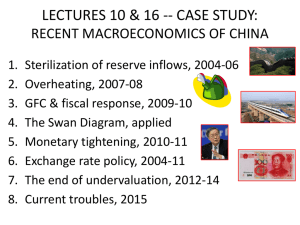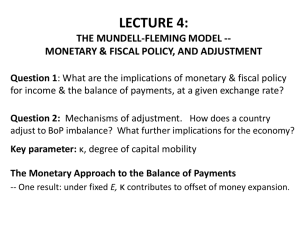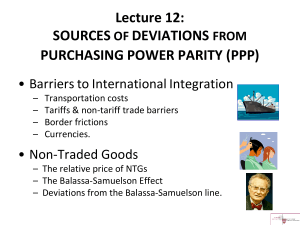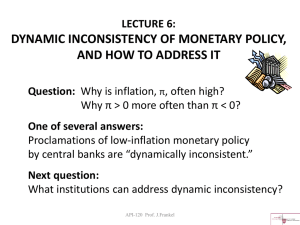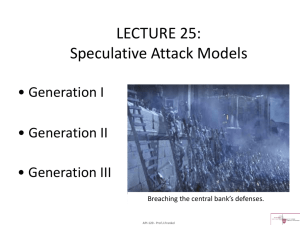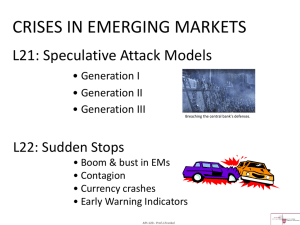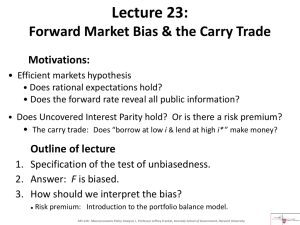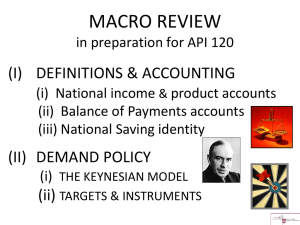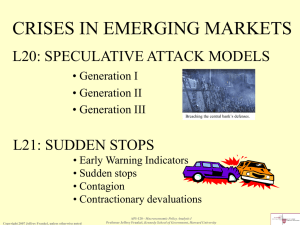RMB
advertisement
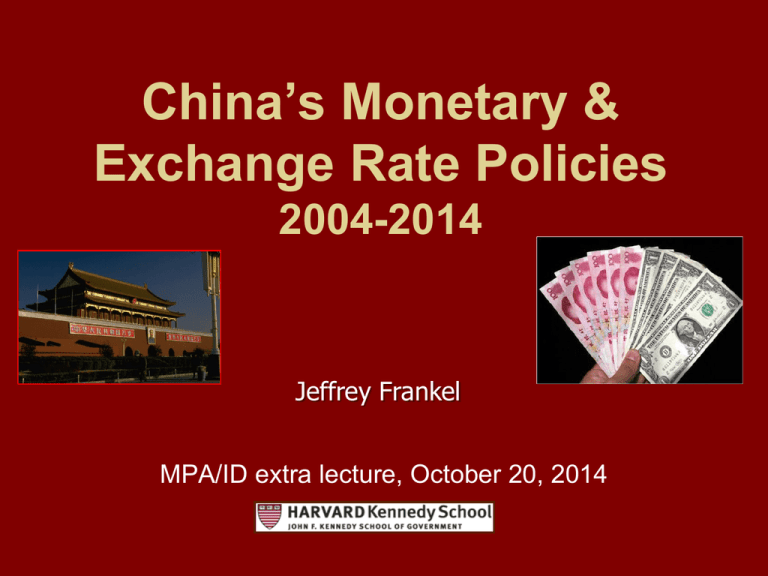
China’s Monetary &
Exchange Rate Policies
2004-2014
Jeffrey Frankel
MPA/ID extra lecture, October 20, 2014
Example of sterilization of money
inflows: China, 2003-2012
API-120 - Prof. J.Frankel, Harvard
China’s Balance of Payments
≡ rate of change of foreign exchange reserves
rose rapidly from 2004 on, due to all 3 components:
trade balance, Foreign Direct Investment, & portfolio inflows
Reserves
Source: HKMA, Half-Yearly Monetary and Financial Stability Report, June 2008
API-120 - Prof. J.Frankel, Harvard
3
FX reserves of the PBoC (largely $) climbed
higher than any central bank in history
API-120 - Prof. J.Frankel,
http://viableopposition.blogspot.com/2012/03/chinas-holdings-of-us-treasuries-what.html
Harvard
http://qz.com/171645/the-invisible-man-managing-chinas-3-8-trillion-in-reserves-just-stepped-down
In 200304,
forex
inflows
accelerated
rapidly.
(Both TB & KA >> 0.)
Initially, the PBoC had no trouble sterilizing the inflows.
=> The MB growth rate was kept down to the growth rate
of the real economy (≈ 10%/year), so there was little inflationary pressure.
In 2007-08 China had more trouble
sterilizing the reserve inflow
• PBoC began to have to pay
higher domestic interest rates
– and to receive lower interest rate on US T bills
– => “quasi-fiscal deficit” or “negative carry.”
• Inflation became a serious
problem in 2007-08.
• Also a “bubble”
in the Shanghai stock market.
Sterilization faltered in 2007 & 2008
Growth of China’s monetary base
& its components:
Money growth
accelerated sharply,
2007-08
Source: HKMA, Half-Yearly Monetary & Financial Stability Report, June 2008
API-120 - Prof. J.Frankel,
Harvard
China’s CPI accelerated in 2007-08
Inflation 1999 to 2008
API-120
- Prof.
Source: HKMA, Half-Yearly Monetary and Financial Stability
Report, June
2008
J.Frankel,
Harvard
Further tools:
The PBoC raised reserve ratios required of banks,
thus sterilizing in the broad sense of slowing M1.
It also raised lending rates.
while continuing to underpay depositors:
{
“financial
repression”
Source: HKMA, Half-Yearly Monetary & Financial Stability Report, June 2008
Chinese inflation fell in 2005, 2008-09,
and again in 2011-14
API-120 - Prof. J.Frankel, Harvard
Appendix: More on China’s sterilization
ΔReserves↑
While increases in reserves (NFA) were large, changes in net domestic assets
(NDA) were negative, limiting rises in the monetary base.
The People’s Bank of China sold sterilization bills
Data: CEIC
Source: Zhang, 2011, Fig.4, p.45.
API-120 - Prof. J.Frankel, Harvard
Sterilization of foreign reserves:
The decreases in PBoC’s net domestic assets
offset increases in foreign assets
API-120 - Prof. J.Frankel, Harvard
Source: Zhang, 2011,
Fig.7, p.47.
Further, the PBoC raised banks’ required reserve ratios,
thus sterilizing in the broad sense of slowing M1, even if M Base grew rapidly
Source: Zhang, 2011,
Fig.6, p.46.
API-120 - Prof. J.Frankel,
Harvard
China’s inflation broke sharply in 2009,
(<= big one-year loss of China’s exports due to global recession).
But took off again in 2010-11.
Inflation, 2001 to 2011
API-120 - Prof. J.Frankel,
Harvard
After the interruption of mid-2008 to mid-2009
overheating resumed: rapid rise of land prices in 2010
Real Beijing land prices
API-120 - Prof. J.Frankel, Harvard
When house prices rise relative even to rents,
it suggests a bubble or easy money
API-120 - Prof. J.Frankel,
Harvard
Scott Reeve blog
China in 2010 resumed attempts to sterilize money
inflows by raising banks’ reserve requirements
-- to slow M1 growth even while MB is growing rapidly.
API-120 - Prof. J.Frankel,
Harvard
China’s tightened
control of
the money supply
to help head off
rising inflation
in 2004, 08,
and again in 2011.
API-120 - Prof. J.Frankel, Harvard
Fxtimes.com
Chinese inflation, once again,
began to ease off after mid-2011
API-120 - Prof. J.Frankel,
Harvard
China-US Exchange
Rate Issues
2004-2014
Historical
timeline
“I have listened to both sides of this
debate. Here is what I think. I think
those who call for a fixed exchange
rate are right in the short run. And
those who call for a floating exchange
rate are right in the long run.
How long is the short run, you ask?
You must understand. China is 8000
years old. So when I say, short run,
it could be 100 years.”
-- Li Ruogu, Deputy Governor,
People’s Bank of China, Dalian, May 2004
22
Historical timeline of currency diplomacy
• 1973: End of Bretton Woods era.
– Major currencies switch from fixed to floating.
The rest keep their pegs.
• 1977:
IMF members agree that each shall
“avoid manipulating exchange rates … to prevent
effective balance of payments adjustment or to gain
an unfair competitive advantage over other members.”
[Principle (A) of the “1977 Decision on Surveillance over Exchange Rate Policies,” and Sect.1, Clause 3, of Article IV amended in 1978.]
– In practice, the IMF seldom pressures
countries to revalue their currencies upward;
• Rather, it pressures deficit countries to devalue.
23
Historical timeline of currency diplomacy
• 1983-84: ¥/$ Agreement.
1985: Plaza Accord.
– Japan, US & others cooperate
to bring down overvalued $, esp. vs. yen .
• 1987-89:
– Louvre Agreement: $ depreciation halted.
– Bubbles in Japan’s equity & real estate markets,
– followed by crash, & severe stagnation in 1990s.
24
Timeline, continued
• 1988: The Omnibus Trade
& Competitiveness Act
mandates the US Treasury
report to Congress biannually on whether
trading partners are manipulating currencies.
– It requires the Treasury to “consider whether countries manipulate
the rate of exchange between their currency and the U.S. dollar
for purposes of preventing effective balance of payments adjustments
or gaining unfair competitive advantage in international trade.''
– The US must hold talks with governments deemed to be breaking rules.
– In the first Reports to Congress on International
Economics & Exchange Rate Policy, Korea &
Taiwan PoC were found to be guilty of manipulation,
• while Singapore & Hong Kong SAR “got off with a warning.”
• China was named in early 1990s.
25
Timeline, continued: Exchange rate
• Jan. 1994: China devalues its official rate,
– unifying its dual exchange rate system.
• 1997-98: East Asia crisis.
– China wins plaudits for keeping RMB fixed
• while its neighbors are devaluing.
• 1995-2005: China continues to peg
– for 10 years
– at 8.28 RMB/$.
26
Timeline, continued: US pressure
• Oct. 2003: Treasury Secretary Snow begins
to “browbeat” China to allow appreciation.
– Treasury Report: RMB merits concern & talks
– Speculators in financial markets start to bet on appreciation.
– as reflected in either capital flows (residual; see Prasad & Wei)
– or non-deliverable forwards (see appendix graph).
• Feb.2005: Senators Schumer & Graham propose
first of bills to impose (WTO-illegal) tariffs
of 27 ½ % against all Chinese goods if China
does not substantially revalue its currency.
– Subsequent versions, by Baucus-Grassley and others
substitute the phrase “currency misalignment” in place
of “unfair manipulation” to ease standard of proof.
27
Timeline,
continued:
China’s macroeconomy
• 2005-06:
Despite large balance of payments surpluses, PBoC
sterilization of reserve inflows prevents excess money growth & inflation.
• 2007-08: Sterilization finally falters:
Money becomes excessive.
– Inflation becomes a serious concern.
– Shanghai stock market experiences a bubble.
• Mid-2008 – early 2009:
Worst of the global recession hits.
– China loses 26% of exports.
– Growth slows; danger of overheating disappears.
• Mid-2009 – 2011:
China resumes very rapid growth
– in response to domestic demand stimulus + renewed exports.
– Danger of overheating returns: esp. real estate bubble.
28
Inflation became a serious concern in 2007-08.
Global recession eliminated excess demand in 2009 – but only briefly.
29
Timeline, continued:
Exchange rate
• July 2005: China announces a new policy,
– Immediate 2.1% revaluation,
– followed by “managed float”: controlled appreciation,
supposedly against an unspecified basket of currencies.
– But, as often, de jure exchange rate regime ≠ de facto.
• Statistical estimation of true regime reveals:
– $ link began to loosen in 2006.
– By 2007, implicit basket had shifted some weight
onto other currencies, especially the €.
– RMB appreciates against the $ from 2006 to 2008
•
but only because € does.
30
Timeline, continued:
Exchange rate
• May 2008: Chinese leaders hear exporter
complaints of competitiveness difficulties.
• Mid-2008-April 2010:
yuan repegs ≈ $ 6.84 RMB/$
• ≈ 17% stronger, vs. $, than 2005.
31
The RMB rose against the $ during 2006-08,
but returned to peg in mid-2008.
32
Timeline, continued
• Oct. 2006 -- IMF Article IV consultation
finds RMB “undervalued.”
• 2007: US Treasury temporarily passes
hot potato of exchange rate complaints to IMF,
– which gets mandate for
exchange rate “surveillance.”
• 2008: Though financial crisis
originates in US, “flight to quality”
raises demand for $.
33
2009: Chinese warnings
– Premier Wen worries US T bills may lose value.
Urges the US to keep its deficit
at an “appropriate size” to ensure
the “basic stability” of the $
(again on 11/10/09).
– PBoC Gov. Zhou, proposes
replacing $ as international
currency, with the SDR (March 09).
– Pres. Obama & Secy. Geithner seek to reassure.
34
April 2010: Collision averted
• US Congress presses Treasury to find China guilty
of currency manipulation in its report due in April.
• But China says it will never bow to pressure.
• April 3: Treasury announces
biannual report postponed.
• Later, China announces switch
to some currency flexibility:
– Starting in June 2010, appreciation vs. $ resumes.
• So both sides save face.
• September 2010 –
Brazil Minister Mantega
warns of “currency wars”:
– Each country intervenes to push its currency down
– in effort to gain trade advantage.
• November 2010, G20 Summit in Seoul –
– China criticizes US Fed’s
monetary easing (“QE2”) as
an example of currency wars.
Five reasons why China should have moved to a
more flexible exchange rate regime, in its own interest
• Excessive reserves (≈ $4 trillion in 2014)
– though a useful shield against currency crises, China has enough reserves.
– Harder to sterilize the inflow over time.
•
Overheating of economy (esp. 2007 & 2010-11)
– inflation
– asset prices.
• Attaining internal and external balance.
– To attain both, need 2 policy instruments.
– In a large country like China, the expenditure-switching policy
should be the exchange rate.
– Along with expenditure-increasing policies (2009).
• Avoiding crisis:
– Experience suggests it is better to exit from a peg in good times,
when the BoP is strong, than to wait until the currency is under attack.
• RMB undervalued, judged by Balassa-Samuelson criterion.
Is the RMB undervalued?
Balassa-Samuelson relationship
• Prices of goods & services in China are low
– compared at the nominal exchange rate.
– Of course they are a fraction of those in the U.S.: < ¼ .
– This is to be expected:
explained by the Balassa-Samuelson effect,
• which says that low-income countries have lower price levels.
• As countries’ real income grows, their currencies experience real
appreciation: approx. .3% for every 1 % in income per capita.
– But China has been one of those countries that is cheap or
undervalued even taking into account Balassa-Samuelson.
38
1
2005
-1
-.5
0
.5
The Balassa-Samuelson Relationship
-3
-2
-1
0
1
Log of Real Per capita GDP (PPP)
2
coef = .23367193, (robust) se = .01978263, t = 11.81
Source: Arvind Subramanian, PB10-08, Peterson Institute for International Economics, 2010.
Undervaluation of RMB in the regression estimated above = 26%.
Estimated 2005 undervaluation averaging across four such estimates = 31%.
Compare to estimate for 2000 (Frankel 2005): 36%.
As recently as 2009 (Chang 2012): 25% .
39
China Adjusts, 2009-13
• Various key measures suggest that China has
achieved a substantial share of the needed
trade adjustment since 2009:
• Its current account surplus peaked in 2008
– > 10% of GDP
– and then narrowed dramatically, to <2% in 2013.
• Substantial real appreciation of the RMB
has brought it closer to equilibrium.
– Some nominal appreciation +
– Some price inflation and, especially, wage increases.
Adjustment of relative prices
• The famous “China price”:
– Ever since China rejoined the world economy
3 decades ago, its trading partners have been
snapping up exports of manufacturing goods,
– because low Chinese wages made them
super-competitive on world markets.
• But relative prices adjusted
– following the laws of market economics.
Adjustment of relative prices, continued
• The change in relative prices is reflected
as real exchange rate appreciation.
– This comprises, in part, nominal appreciation
– and, in part, Chinese inflation.
– Government officials would have been better advised
to let more of the real appreciation take the form
of nominal appreciation ($ per RMB).
– But since they didn’t, it showed up as inflation instead.
– See charts below:
• appreciation, against the $ and other currencies.
Appreciation versus the US $, 2005-12
1.5
1.4
CNY/USD,
2005M06=1
1.3
real
1.2
nominal
1.1
1.0
0.9
2005
2006
2007
2008
2009
2010
2011
Appreciation vs. index of currencies, 2005-12
1.35
1.30
CNY Index,
2005M06=1
1.25
1.20
Real value
of CNY
1.15
Value
of CNY
1.10
1.05
1.00
0.95
2005
2006
2007
2008
2009
2010
2011
China’s trade balance
The surplus peaked in 2007, and then fell.
Source: Reserve Bank of Australia (June 2013)
China runs a deficit in primary products, offset by a surplus in manufactures.
China’s trade balance
The bilateral surplus with the United States
is as big as ever – which has no economic importance,
but is politically sensitive.
46
The natural adjustment process was delayed.
• 1st, because the authorities intervened to keep
the exchange virtually fixed against the dollar, in
the years 1995-2005 and 2008-2010.
• 2nd, wages had not fully adjusted to (rising)
marginal product of labor in coastal factories
– surplus labor in countryside (A.Lewis, 1954)
– impediments to migration (hukou system).
• China continued to undersell the world.
But prices eventually adjusted.
• Labor shortages began to appear =>
China’s urban workers won rapid wage hikes.
• Meanwhile another cost of business,
land prices, have risen even more rapidly.
• The yuan was finally allowed to appreciate
against the $ during 2005-08 & 2010-11,
by 25% cumulatively
• =17% + 8%,
• though less against other currencies.
Chinese wages have been rising
Source: “China’s wage inflation,” Aug. 28, 2013
49
Overheating showed up in rising land prices
2009-10
Real Beijing land prices
50
…and again in 2013
Rate of increase of housing prices
in 4 major Chinese cities (year-on-year)
51
Source: Gwynn Guilford — Sept. 6, 2013
Real appreciation
• The RMB’s real appreciation against the $
from 2009 to 2013 amounted to 12%,
• reducing the degree of undervaluation by roughly 1/2,
• depending on whether one measures it against the $
or against all currencies.
• China’s real exchange rate is already closer to this
measure of equilibrium than are many countries’
exchange rates (Cheung, Chinn & Fuji, 2010).
A trend of real appreciation since 2005
Dooley, Folkerts-Landau, Garber (2014)
Balassa-Samuelson estimated for 2011
In 2014, the ICP released new absolute price data.
“Is the Renminbi Still Undervalued? Not According to New PPP Estimates”
M.Kessler & A.Subramanian, PIIE, May 2014
Benchmark years
2005
2011
GDP per capita (in PPP dollars)
RMB undervaluation (percent)
4,802
10,057 - Prof. J. Frankel
API-120
-34.5
-9.7
5 types of adjustment are gradually taking place
in response to the new high level of costs
in the factories of China’s coastal provinces:
• 1st, some manufacturing is migrating inland,
– where wages & land prices are still relatively low.
• 2nd, export operations are shifting to Vietnam or Bangla Desh
– where wages are lower still.
• 3rd, Chinese companies are beginning to automate,
– substituting capital for labor.
• 4th, they are moving into more sophisticated products,
– following the path blazed earlier by Japan, Korea, & other Asian tigers
• in the “flying geese” formation.
• 5th, multinational companies that had in the past moved some
stages of their production process to China, out of the US
or other high-wage countries, are now moving back.
• All five of these ways of reallocating
resources represent the economic
process operating as it should.
•
None of this comes as news
to most observers of China.
• But many Western politicians are unable
to let go of the syllogism that seemed
so unassailable just a decade ago:
– (1) The Chinese have joined the world economy;
– (2) their wages are $0.50 an hour;
– (3) there are a billion of them, and so
– (4) their exports will rise without limit:
“Chinese wages will never be bid up in line
with the usual textbook laws of economics
because the supply labor is infinitely elastic.”
• But it turns out that the laws of economics do
eventually apply after all -- even in China.
Expansion of the services sector.
This 6th dimension of adjustment still lags behind,
• despite the consensus in favor of it.
• China has had great success in manufacturing
– especially via exports.
• Now it needs to help the other side of the economy
catch up: services, via domestic demand
– Retail, education, environmental quality,
– health care, pensions, social safety net.
• Some of this could be done via government spending
– with the economy in slowdown in 2014,
– as China did in 2009; but that was heavy investment.
China’s position in the Swan Diagram in 2008 called
for real appreciation. In 2009, also demand expansion.
ED & TB>0
in RMB/$
Excgange rate E
China
2008, 10
China
2009, 14
ES & TB>0
BB:
External balance
CA=0
ED & TD
China
2002
ES & TD
Spending A
YY:
Internal balance
Y=𝑌
59
References by Frankel
• “China Adjusts,” Project Syndicate, March 2012.
• “Historical precedents for the internationalization of the RMB;”
•
•
written for a workshop in Beijing of CFR & China Development Research
Foundation, 2011. Extended in Journal of Economic Integration 2012, vol.27,
no.3, pp. 329-65. Summary at RIETI & Vox.
"The Renminbi Since 2005," in The US-Sino Currency Dispute: New Insights
from Economics, Politics and Law, edited by S.Evenett (CEPR: London) 2010.
“New Estimation of China’s Exchange Rate Regime,” in Pacific Economic
Review 14, no.3, 2009. NBER WP no. 14700.
• “Comment on ‘China’s Current Account and Exchange Rate,’ by Yin-Wong
Cheung, Menzie Chinn & Eiji Fuji,” in China’s Growing Role in World
Trade, edited by Feenstra & Wei (University of Chicago Press, 2010).
• “Comments on Cline and Williamson’s ‘Estimates of the Equilibrium
Exchange Rate of the Renminbi’,” in Debating China's Exchange Rate Policy,
M.Goldstein & N.Lardy, eds. (Peterson Institute for International Economics), 2008.
• "Assessing China's Exchange Rate Regime," with Shang-Jin
Wei, Economic Policy 51, 2007. NBER WP 13100.
• "On the Yuan: The Choice Between Adjustment Under a Fixed Exchange
Rate and Adjustment under a Flexible Rate," in Understanding the Chinese
•
Economy, edited by G. Illing (Oxford U. Press), 2006. NBER WP 11274.
“On the Renminbi,” CESifo Forum, 6, no.3, 2005 (Ifo IER, Munich).
http://ksghome.harvard.edu/~jfrankel/
2013 statistics
HKTDC, March 2013
Changes in minimum wages in Guangdong
Mar 2011 (RMB/mo.)
Guangzhou
1,300
Zhuhai, Foshan, Dongguan, Zhongshan
1,100
Shantou, Huizhou, Jiangmen
950
Shaoguan, Heyuan, Meizhou, Shanwei,
Yangjiang, Zhanjiang, Maoming, Zhaoqing,
Qingyuan, Chaozhou, Jieyang, Yunfu
850
Shenzhen
1,5001
1
Effective 1 Feb 2012
2
Effective 1 March 2013
May 2013 (RMB/mo.)
1,550
1,310
1,130
1,010
1,6002
% Δ since last increase
19.2
19.1
18.9
18.8
6.7
61
Source: Human Resources and Social Security Office of Guangdong and Shenzhen
In response to rising wages, some laborintensive manufacturing has moved out of China
Mexican employment is rising
Source: Noel Maurer,
April 2013
62
